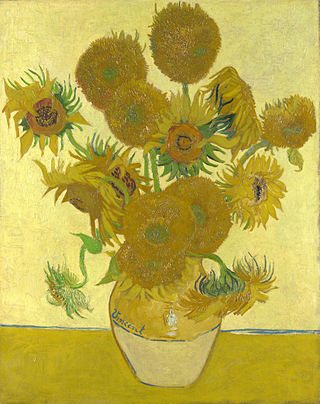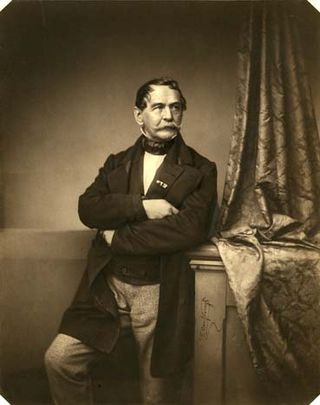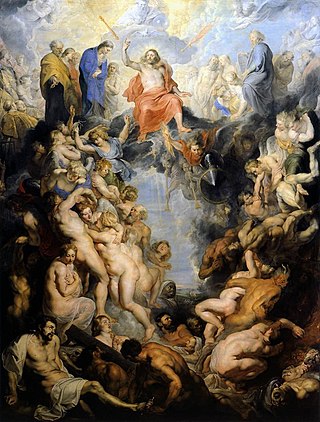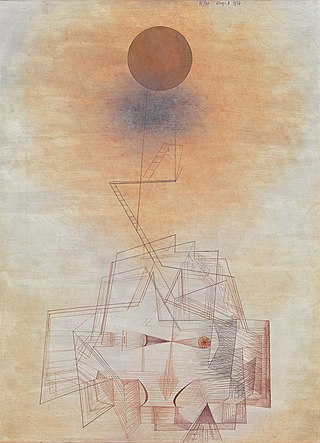
Maria Anna Angelika Kauffmann, usually known in English as Angelica Kauffman, was a Swiss Neoclassical painter who had a successful career in London and Rome. Remembered primarily as a history painter, Kauffman was a skilled portraitist, landscape and decoration painter. She was, along with Mary Moser, one of two female painters among the founding members of the Royal Academy in London in 1768.

Wilhelm von Kaulbach was a German painter, noted mainly as a muralist, but also as a book illustrator. His murals decorate buildings in Munich. He is associated with the Düsseldorf school of painting.

Peter von Cornelius was a German painter; one of the main representatives of the Nazarene movement. He was the uncle of the composer Peter Cornelius (1824–1874).

Sunflowers is the title of two series of still life paintings by the Dutch painter Vincent van Gogh. The first series, executed in Paris in 1887, depicts the flowers lying on the ground, while the second set, made a year later in Arles, shows a bouquet of sunflowers in a vase. In the artist's mind, both sets were linked by the name of his friend Paul Gauguin, who acquired two of the Paris versions. About eight months later, van Gogh hoped to welcome and impress Gauguin again with Sunflowers, now part of the painted Décoration for the Yellow House that he prepared for the guestroom of his home in Arles, where Gauguin was supposed to stay.

Anton Zwengauer was a German painter of the Biedermeier period.

The Alte Pinakothek is an art museum located in the Kunstareal area in Munich, Germany. It is one of the oldest galleries in the world and houses a significant collection of Old Master paintings. The name Alte (Old) Pinakothek refers to the time period covered by the collection—from the fourteenth to the eighteenth century. The Neue Pinakothek, re-built in 1981, covers nineteenth-century art, and Pinakothek der Moderne, opened in 2002, exhibits modern art. All three galleries are part of the Bavarian State Painting Collections, an organization of the Free state of Bavaria.

Maximilian Emanuel Ainmiller was a German artist and glass painter.

The Neue Pinakothek is an art museum in Munich, Germany. Its focus is European Art of the 18th and 19th centuries, and it is one of the most important museums of art of the nineteenth century in the world.

Leo von Klenze was a German architect and painter. He was the court architect of Ludwig I of Bavaria.

Eugen Napoleon Neureuther was a German painter, etcher, and illustrator.

Wilhelm von Kobell was a German painter, printmaker and teacher.

Peter Heinrich Lambert von Hess was a German painter, known for historic paintings, especially of the Napoleonic Wars and the Greek War of Independence.

Clemens von Zimmermann was a German historical painter. He is associated with the Düsseldorf school of painting.
1000 Meisterwerke was a West German art series. It followed the highly successful British series 100 Great Paintings. From 1981 through 1994, the West German broadcaster WDR produced the series, which was broadcast by ARD, ORF and BR. In each of the 10-minute broadcasts, a single painting was presented and analyzed by an art historian. The Sunday evening broadcasts had five million viewers.

The Great Last Judgement is an oil on canvas altarpiece, painted by the Flemish artist Peter Paul Rubens between 1614 and 1617. He created the composition and final touches and his is the only signature on the work, though it is believed between nine and nineteen studio assistants also worked on it. Its name distinguishes it from the same artist's The Small Last Judgement of 1619 and his The Fall of the Damned of 1620.

The Sin is an 1893 painting by the German artist Franz Stuck. Stuck created twelve known versions of the painting. Some of these can be viewed at the Neue Pinakothek, in Munich, the National Gallery, in Berlin, the Galleria di arte Moderna, in Palermo, the Frye Art Museum, in Seattle, and at the Villa Stuck, in Munich, where it is enshrined in the artist's Künstleraltar. It depicts the nude Eve with a large serpent wrapped around her body. In the upper right corner is a bright field, while the rest of the surroundings are dark.

Limits of Reason is a 1927 painting by Paul Klee (1879-1940). It is in the permanent collection of the Pinakothek der Moderne—Pinakothek of modern art—in central Munich's Kunstareal.

Carl Friedrich Heinzmann was a German landscape and porcelain painter; also known as a lithographer.

Johann Caspar Herterich, sometimes known as Hans was a German history and genre painter. He was also a popular Professor at the Academy of Fine Arts, Munich.

The siege of Philippsburg was a French siege of the Rhine fortress of Philippsburg during the Thirty Years' War. After the battle of Freiburg in early August, the French under the Duc d'Enghien refrained from attacking the city and marched north to besiege the imperial-held Philippsburg instead. The place fell after a two-week siege.



















